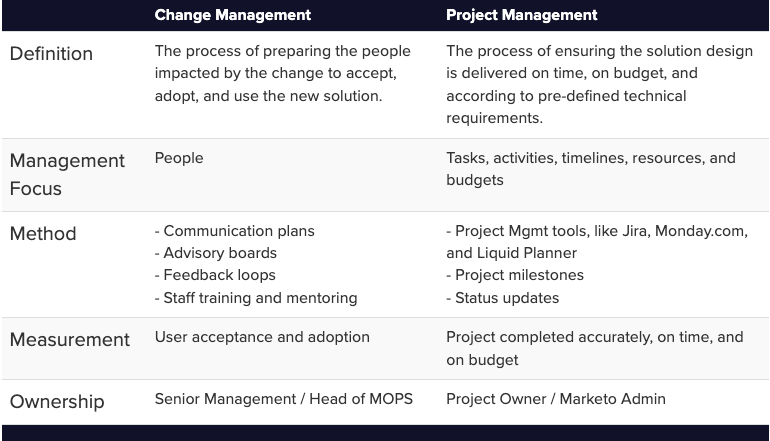Ch-ch-ch-changes! What’s that saying— if you’re not changing, you’re not growing?
Of course, at times, who hasn’t secretly wished that maybe your organization could do a little less growing—?
Without a doubt, change is hard. Change is also occurring at increasingly rapid rates as organizations continue to adapt to post-pandemic operating environments. In fact, 53% of enterprises are prioritizing a culture receptive to change to enable more organizational agility. Change often begins in marketing operations, and it’s not surprising Forrester predicts the CMO will emerge as the change agent for an organization.
From a new Marketo project to shoring up your marketing operations processes, every initiative involves change. And somebody has to keep both the project pacing accordingly and the people moving forward appropriately to deliver change successfully. Hence, enter the need for project management and change management— they go hand-in-hand. Otherwise, productivity is lost, and momentum will suffer when a project or user acceptance and adoption isn’t well…managed.
Project Management vs. Change Management
Ever had a situation where marketing operations was using more sophisticated technologies than the field sales team, and you wanted to not only update the process but implement best practices? Perhaps sales has been keeping contacts in Outlook, on paper, or (gasp) in a Rolodex.
To arrive at the desired outcome, it involves both project management to migrate the leads to the CRM, and change management as the new process will be a cultural shift— sunsetting prior practices, changing behaviors, training the sales team how to use the new CRM tool, and ensuring lead status fields are correctly populated so marketing campaigns can be tracked.
Driving change is likely one of the more challenging pieces of a marketing leader’s job and a significant consideration in pursuing Marketo Value Realization— stage 3 of our value realization cycle, “Activation.”
Perhaps you’ve experienced the tell-tale signs of poor project management— misalignment with the team, stakeholders, and business requirements; flawed design execution, missed implementation deadlines, and over budget. Similarly, a failing change management plan leads to lackluster project adoption, mediocre user acceptance, and underperforming outcomes.
As another example, let’s say you want to change the criteria of an MQL. Best practice is to involve the sales team from the get-go, before any changes are made. Including sales in discussions about what demographic and behavioral criteria define an MQL, lead scoring, and your ideal customer profile, sets the stage to design your solution efficiently and allows sales to champion the change.
By looping in sales early on, they understand behavioral data and can more effectively follow-up on the lead.
When change management and project management are working together, it drives positive change and successful results. However, the two disciplines are often misunderstood and taken for granted. Let’s take a look at how they compare.

The Impact of Change and Project Management Combined
Overall, a structured approach to both project and change management leads to repeatable processes. See how together they drive business outcomes in this infographic:

Integrating Project and Change Management to Drive Marketo Value Realization
According to Prosci, organizations who integrate project and change management are 17% more likely to meet or exceed project objectives— the two disciplines fuel Marketo Value Realization and optimize your outcome. How can you support the functional integration?
Dedicate financial resources to support project and change management
An effective project strategy allocates proper resources (technology, people, and budget) to ensure your success. Considering the success of your entire project is on the line, investing in project and change management should not be viewed as “optional” or an “expense,” but rather a “safeguard” of your overall investment. Without project and change management, your outcome is a gamble.
Include change management strategies in your project management plan
When employees feel heard, they are more apt to participate, provide input, and take action. Individual contributors also influence team behavior; be sure to involve employees early and throughout your project phases. A good project roadmap will always include training time and incorporate a staff feedback loop. And, if choosing a Marketo agency partner, ask specifically who will be leading your project and how change management will be addressed— glossing over the details is a red flag.
Validate user adoption post-implementation
A new process is implemented, and everyone is trained, but is anyone actually following it? Is the new process efficient? Post-implementation follow-up is often the most missed piece of a project roadmap; leverage your feedback loop to gain insight into how the team is receiving and using the new solution. Capturing smaller issues before they become more significant is key to your long-term project success.
Summing It All Up
Change is never easy, especially when shifting processes and technology. Both project management and change management provide the structure to keep everyone aligned with the direction, accountable to the project’s success, and on track with the defined milestones and objectives. Ultimately, your goal is repeatable processes and predictable outcomes. By effectively managing your project and the people impacted by your project, you will accomplish your objectives and attain more value from Marketo faster.